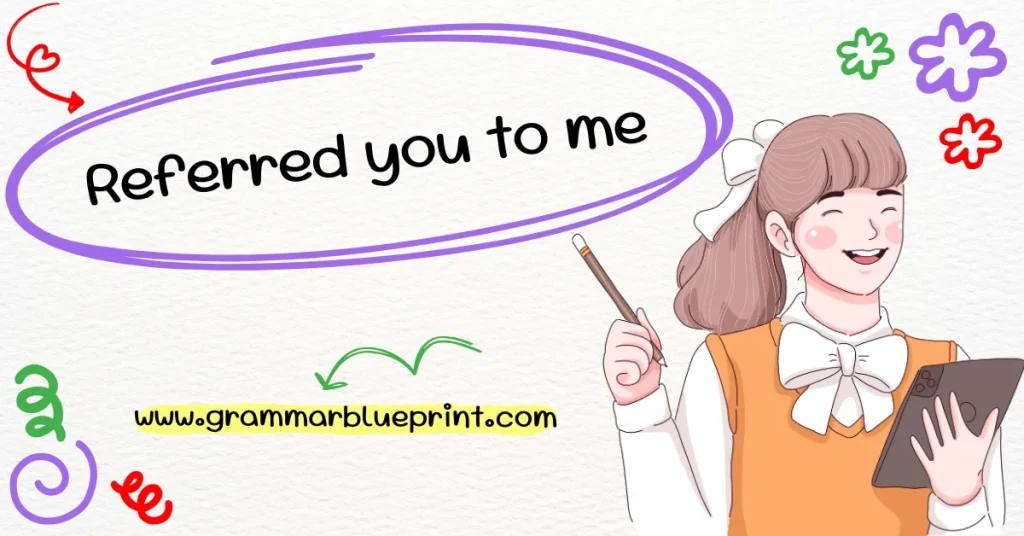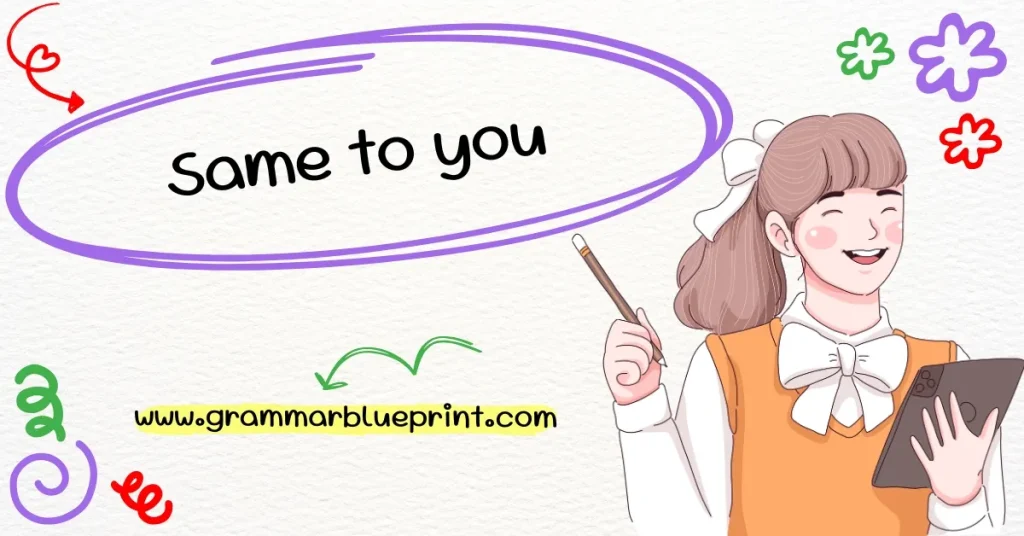Have you ever been told that someone “referred you to me”? It’s a common phrase, but what exactly does it mean? In this blog, I’ll break down the phrase, show you how to use it, and explain how it can improve your everyday English communication. Let’s dive into it!
What is “Referred You to Me”?
The phrase “referred you to me” is one you might encounter quite often in both casual and formal conversations. Let’s break it down for easy understanding:
Referred: The verb “refer” means to direct someone to a person or resource for help, advice, or information. When someone “refers” you to someone else, they are recommending you speak with or contact that person.
You to me: This part clarifies who is being referred and to whom. In this case, “you” is the person being directed, and “me” is the person being recommended (the one who has the knowledge, skill, or assistance you may need).
Put it all together, and “referred you to me” means that someone has recommended or pointed you in the direction of a specific person for assistance or advice.
How to Use “Referred You to Me” in Sentences
Now that we understand the phrase, let’s take a look at how to use it in sentences. It’s an incredibly versatile phrase that you can use in different contexts, whether formal, casual, or academic.
Examples in Different Contexts
- Formal:
“Mr. Smith referred you to me for advice regarding the project proposal.”
This is a formal use of the phrase in a professional environment. It conveys that someone in a position of authority has recommended the person reach out to you for assistance. - Casual:
“Oh, Jamie referred you to me, right? How can I help you?”
In a more casual conversation, this phrase can sound friendly and approachable, perfect for day-to-day interactions or casual business settings. - Academic:
“Professor Johnson referred you to me for a consultation about your thesis.”
In academic settings, you may use this phrase to show that a professor or advisor has suggested that a student contact you for specific academic guidance.
Correct Usage in Conversations
When using “referred you to me” in conversations, it’s important to use the phrase naturally and with the right tone. Here are a couple of examples for conversational settings:
- In a professional email:
“Hi [Name], I hope you’re well. John referred you to me regarding your inquiry about our services. How can I assist you today?” - In a casual chat:
“Hey, I heard Sarah referred you to me. What’s going on? Let’s chat!”
The key to correct usage is making sure the sentence flows and matches the tone of the conversation, whether you’re in a formal business email or a friendly, informal exchange.
Referred to vs. Referred by
You might be wondering, “What’s the difference between ‘referred to’ and ‘referred by’?” Good question! Let’s break it down:
Difference in Meaning
- Referred to:
When you say someone “referred you to me,” it means they directed you toward the person or resource that can assist you. The focus is on the person or thing being pointed to. - Referred by:
On the other hand, “referred by” places the emphasis on the person who made the referral. For example, “I was referred by John” means John is the one who recommended or suggested you.
In short, “referred to” highlights the person or service you’re being directed to, while “referred by” highlights the person who’s doing the referring.
Examples of Each Phrase
- Referred to me:
- “Jane referred you to me for assistance with your presentation.”
- “I was referred to Sarah for a second opinion on my report.”
- Referred by me:
- “You were referred by John, and I’m happy to help you.”
- “She was referred by her professor to our tutoring services.”
Common Mistakes with “Referred You to Me”
Even though “referred you to me” is a relatively straightforward phrase, there are still a few common mistakes that learners often make. Let’s dive into them and see how you can avoid them!
Misunderstanding the Structure
One of the most common mistakes is misunderstanding the structure of the phrase. Sometimes learners mix it up with other phrases, or they might confuse the sentence construction. For example, they might say:
- Incorrect: “He referred me to you.”
(This is actually correct, but in the wrong context. It should be used when the person is directing you towards someone else, not when someone is directing someone else to you.) - Incorrect: “I referred you to me.”
(This sounds awkward. The phrase “referred you to me” should be used instead to maintain clarity.)
Tip: Focus on the order of the words. “Referred you to me” follows the pattern of “someone referred [you] to [me]”—simple and direct.
How to Avoid Errors
Now that we’ve covered the common mistakes, here’s how to avoid them and get the structure right every time:
- Remember the Direction: The person who is doing the referring (e.g., “he” or “she”) should come first, followed by the person being referred (e.g., “you”), and then the person who is being recommended (e.g., “me”).
Correct Example:- “He referred you to me for advice.”
- “She referred you to me for help with your resume.”
- Use the Right Preposition: Ensure you’re using “to” instead of “by” when you mean that someone directed another person to you.
Correct Example:- “He referred you to me for assistance.”
- “John referred you to me.”
- Practice Makes Perfect: To get the hang of this phrase, it’s helpful to practice using it in everyday conversations, whether in emails, meetings, or casual chats.
Synonyms for “Referred You to Me”
The phrase “referred you to me” can be reworded using various alternatives that have a similar meaning. If you feel like mixing it up or want to use something a little different, here are 25 alternatives:
1. Recommended you to me
-
- Meaning: Suggesting you reach out to someone for help.
- Best Use: Professional recommendations.
- Tone: Formal
2. Directed you to me
-
- Meaning: Pointing you in the direction of someone who can assist.
- Best Use: General use, especially in professional settings.
- Tone: Neutral
3. Suggested you to me
-
- Meaning: Offering someone as a potential contact.
- Best Use: Informal or casual conversations.
- Tone: Friendly
4. Sent you my way
-
- Meaning: Informally directing someone to you.
- Best Use: Casual contexts, e.g., “Sarah sent you my way.”
- Tone: Casual
5. Pointed you towards me
-
- Meaning: Indicating you should contact someone.
- Best Use: Friendly conversations.
- Tone: Casual
6. Put you in touch with me
-
- Meaning: Facilitating a connection between two people.
- Best Use: Both formal and casual contexts.
- Tone: Neutral
7. Connected you with me
-
- Meaning: Making an introduction or contact between two parties.
- Best Use: Professional introductions.
- Tone: Professional
8. Introduced you to me
-
- Meaning: Helping someone meet or know about you.
- Best Use: More formal scenarios.
- Tone: Formal
9. Directed you here
-
- Meaning: Giving specific instructions on where to go or whom to see.
- Best Use: Directions in both formal and casual settings.
- Tone: Neutral
10. Told you about me
-
- Meaning: Sharing information about a person.
- Best Use: Informal contexts.
- Tone: Casual
11. Guided you to me
- Meaning: Helping someone find their way to you for assistance.
- Best Use: When someone has been given directions or advice to reach you.
- Tone: Friendly, helpful
12. Informed you about me
- Meaning: Giving someone details or background about you.
- Best Use: Professional emails or formal introductions.
- Tone: Neutral, formal
13. Sent you to me
- Meaning: Directing someone to you, usually for help or information.
- Best Use: Used when someone gives you specific instructions to reach out to another person.
- Tone: Neutral, general
14. Passed your details on to me
- Meaning: Sharing someone’s information with you for future contact.
- Best Use: When you’ve been given someone’s contact information for follow-up.
- Tone: Professional, neutral
15. Gave you my contact
- Meaning: Providing someone with your contact information.
- Best Use: When referring to sharing personal or professional contact info.
- Tone: Friendly, casual
16. Put you in contact with me
- Meaning: Facilitating a direct connection between you and another person.
- Best Use: When you’re formally introducing someone to a point of contact.
- Tone: Professional, formal
17. Hooked you up with me
- Meaning: Informally arranging a meeting or connection with someone.
- Best Use: Informal, casual interactions, usually when facilitating an easy connection.
- Tone: Very casual, friendly
18. Recommended my services
- Meaning: Suggesting that someone utilize your professional help or services.
- Best Use: When someone suggests a professional’s expertise.
- Tone: Professional, business-oriented
19. Introduced you to my work
- Meaning: Helping someone become familiar with your work or projects.
- Best Use: Used when suggesting someone look into your professional contributions.
- Tone: Professional, academic
20. Directed you towards my expertise
- Meaning: Pointing someone to your specific knowledge or skill set.
- Best Use: In professional or academic contexts where expertise is relevant.
- Tone: Professional, authoritative
21. Suggested my name to you
- Meaning: Recommending you as a point of contact for help or services.
- Best Use: When someone gives your name as a reference for future assistance.
- Tone: Friendly, semi-formal
22. Made an introduction to me
- Meaning: Introducing one person to another for collaboration or assistance.
- Best Use: In professional or academic settings where introductions are essential.
- Tone: Formal, professional
23. Helped you find me
- Meaning: Assisting someone in locating your contact or services.
- Best Use: Casual, helping someone figure out how to reach you.
- Tone: Casual, helpful
24. Brought you to me
- Meaning: Bringing someone directly to you for assistance or consultation.
- Best Use: Used in scenarios where a person is physically brought or directed to you.
- Tone: Casual, friendly
25. Provided you with my details
- Meaning: Offering someone the information necessary to contact you.
- Best Use: Professional or formal context when providing business contact info.
- Tone: Neutral, professional
26. Sent you my way for advice
- Meaning: Directing someone to you because you can offer guidance or advice.
- Best Use: When you’re the go-to person for assistance or expertise.
- Tone: Informal, approachable
27. Connected you with my services
- Meaning: Connecting someone to the professional services you offer.
- Best Use: When facilitating access to your professional services.
- Tone: Formal, professional
28. Told you to reach out to me
- Meaning: Giving someone instructions to contact you directly.
- Best Use: Casual or informal, used in a conversation where a person is encouraged to reach out.
- Tone: Friendly, casual
29. Informed you to contact me
- Meaning: Letting someone know that they should reach out to you.
- Best Use: When you need someone to get in touch with you for a purpose.
- Tone: Professional, neutral
30. Led you to me
- Meaning: Guiding someone directly to you for help or support.
- Best Use: Used when someone assists in guiding another person towards you.
- Tone: Neutral, helpful
Why Use “Referred You to Me”?
Understanding how and why to use “referred you to me” can greatly enhance the clarity and professionalism of your communication. But beyond just knowing how to use it, it’s important to recognize why it’s such a valuable phrase. Let’s explore its benefits and see how it can improve your English, both professionally and in daily conversations.
Benefits for Clear Communication
One of the major reasons to use phrases like “referred you to me” is that it brings clarity to your communication. When you mention that someone referred another person to you, it immediately provides context about the conversation. This makes it easier for both parties to understand the reason for the interaction.
For example:
- “Alex referred you to me for advice on the new software implementation.”
This sentence immediately tells the other person why you’re talking to them and what they can expect from the conversation. The person being referred to you already knows the purpose of the connection, which saves time and energy.
This directness is especially useful in professional and academic settings, where clarity is essential for efficiency. Instead of having to explain why you’re having a conversation, using “referred you to me” sets the tone right from the start.
Enhancing Professional and Academic English
In both professional and academic contexts, clear communication is paramount. By using a phrase like “referred you to me,” you immediately establish a more formal and structured tone, showing that you understand the nuances of professional communication.
- Example in business email:
“Dear Mr. Roberts,
I hope this message finds you well. Jane Doe referred you to me regarding your recent inquiry about our consulting services. I would be happy to assist you further.”
Here, not only is the phrase used correctly, but it helps establish a polite, professional tone. It helps your message sound organized, professional, and courteous, all of which are important when communicating with colleagues, clients, or professors.
Similarly, in academic writing or communication, using this phrase signals professionalism and attention to detail. It shows that you’re not only adept at English, but also capable of navigating formal and business-like interactions smoothly.
Practical Tips for Mastering “Referred You to Me”
As we’ve seen, “referred you to me” can be an incredibly useful phrase. But how can you ensure that you’re using it with confidence and precision? Here are some practical tips to help you master the phrase and use it correctly in various situations.
Listen to Native Speakers
One of the best ways to get a feel for how “referred you to me” works in context is to listen to how native speakers use it. You can easily find podcasts, YouTube videos, or even real-life conversations where this phrase is used naturally. By listening to these examples, you’ll understand how the phrase fits into everyday language, making it easier for you to incorporate it into your own speech and writing.
Try to pay attention to:
- Tone: Is the phrase used in a formal, casual, or semi-formal way?
- Context: How is the phrase used in different settings, like work, school, or with friends?
This kind of exposure will help you understand the flow of natural conversation and give you a more authentic grasp of how to use the phrase.
Practice with Real-Life Scenarios
The more you practice using “referred you to me,” the more natural it will feel. Start by thinking of real-life scenarios where you might use it. For example, if a friend recommends you to someone for advice, you could say:
- “Oh, Sarah referred you to me. How can I help?”
Or, if you’re writing an email to a colleague or client:
- “John referred you to me for assistance with the report you mentioned.”
By putting the phrase into practice in these everyday situations, you’ll become more comfortable using it confidently in your conversations and writing.
Use in Writing and Speaking
Whether you’re drafting an email, preparing a report, or just chatting with a colleague, try to incorporate “referred you to me” as often as possible. The key is to use it in both written and spoken forms. This will help you master it in all aspects of communication.
For instance, you could use it in:
- Emails: To clarify why you’re connecting with someone or to explain how you know them.
- Meetings: To explain a connection or introduction that has been made between parties.
- Casual Conversations: To indicate that someone has recommended you to another person.
By using it in a variety of settings, you’ll build confidence and fluency.
Conclusion
We’ve covered a lot of ground in this article, from understanding the meaning of “referred you to me” to exploring the importance of using it effectively. The key takeaway is simple: mastering this phrase can significantly improve your communication, whether you’re talking to colleagues, classmates, or new acquaintances.
By using “referred you to me” correctly, you enhance both clarity and professionalism in your conversations. And as with any new phrase, practice is your best friend. Keep using it in writing, speaking, and listening, and soon enough, it will become second nature.
So, the next time someone says they were “referred to you,” you’ll know exactly how to use the phrase with confidence!



